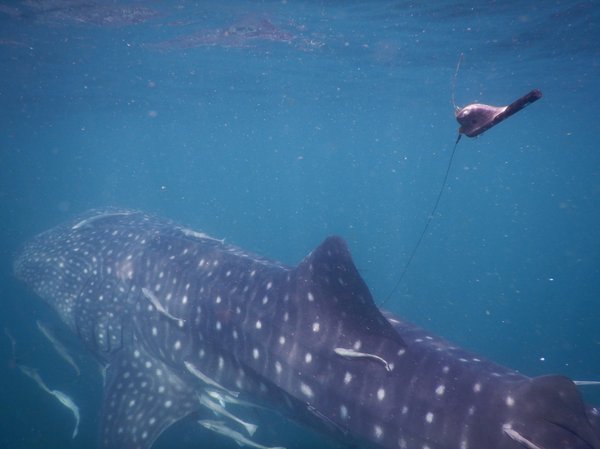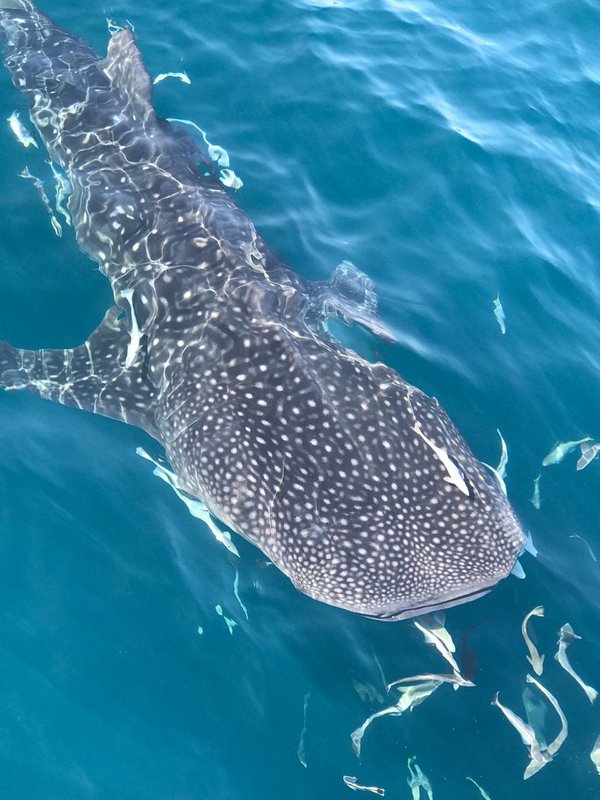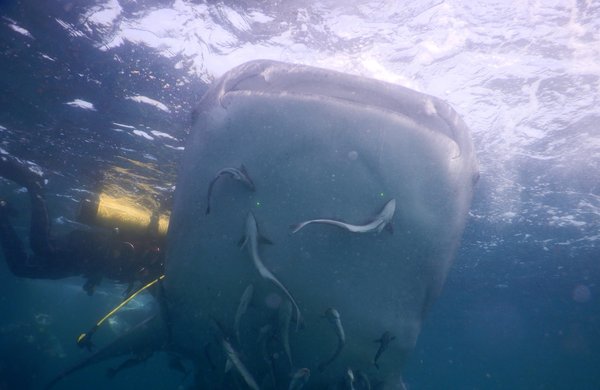Protecting it from Extinction and Promote Economic Development.. Center of Environment and Water Study the Characteristics and Behavior of the "Whale Shark"
Feb. 10, 2020 | ResearchConserve and sustain the oceans, seas and marine resources and reducing pollution is a top priority for countries to secure their natural resources. The behavior study of marine organisms and their properties contributes to an understanding of the marine environment and the impact of climate changes on these organisms, which helps in taking appropriate measures to preserve them from extinction and preserve the environmental balance of the seas.
In addition to the study of marine biology and soil, the assessment of environmental impact and monitoring are among the main research activities of KFUPM Environmental and Water Center in order to preserve the environment.

A research team led by Dr. Hua Hsun Hsu, a researcher at the Center for Environment and Water, carried out a research project aimed at studying sharks since 2016.
A Sustaining Project based on questionnaire to fishermen, sighting reports, and boat surveys, the research team documented two whale sharks and did scientific measurements in October 2018, and then tagged another three whale sharks using satellite tracking device during Oct-Nov 2019. The device records temperature and depth information, and transmit coordinates every day when whale sharks swim near surface. Tracking whale sharks via satellite devices is used for the first time in the Arabian Gulf Saudi. Now we know these three whale sharks where they are going, and realize what temperature and depth they prefer to stay. In 2020, KFUPM team plan to attach the device on five or more individuals.

In addition to track whale sharks, KFUPM team found that Jana Island may be one of whale shark aggregation sites in Saudi Arabian Gulf. Unlike other predatory sharks, whale sharks without sharp teeth and strong jaws are harmless to human, they are also called ‘Gentle Giant of the Sea’, thus many aggregation sites in the world have been developed ‘whale shark ecotourism’, tourists watch and swim with whale sharks. Even though whale sharks gather in Jana for around only two months each year, we still believe that Jana is a potential site to develop ecotourism industry in the future, and will attract more tourists to visit the Kingdom.
The whale shark (Rhincodon typus) is the largest fish in the world. It can grow to at least 12 m total length and may attain lengths of 17-18 m or even 21.4 m with total weight larger than 42 mt. It is one of three filter-feeding sharks and the only one that can consume a wide variety of planktonic and nektonic prey. They inhabit the surface layers of tropical and subtropical waters of the world’s oceans, including the Arabian Gulf.

Whale sharks are sensitive to fisheries operation due to their special biological characteristics, such as very slow growth, late maturity, and long life span. This species is valued for its meat and fins, and is threatened by fisheries either target or bycatch. Because their surface feeding behavior and relatively low swimming speed, once encounter a whale shark, fishermen can easy to catch, so that whale sharks were caught in a big amount since 90’s, and the populations were suspected decline in excess of 20 %. Therefore, the whale shark was assessed as Endangered status on IUCN (The International Union for Conservation of Nature) Red List in 2000, and addressed in CITES (The Convention on International Trade in Endangered Species of Wild Fauna and Flora) Appendix II in 2002 to restrict international trade.

The whale shark was named in 1828, until now, lots of mysteries still remain. This species is an iconic marine wildlife around the world for almost 30 years, but it started to be concerned in the Arabian Gulf since early year of this decade. Their ecology in the Arabian Gulf has been the focus of some studies in recent years. These studies indicated that whale sharks’ seasonal gatherings are related to marine platforms, and also suggested that whale sharks might aggregate in Saudi Arabian waters, which has the most platforms in the Arabian Gulf.

Dr. Hua Hsun Hsu is currently a research scientist III, Center for Environment and Water, KFUPM. He got Ph. D. degree from Department of Environmental Biology and Fisheries Science, National Taiwan Ocean University, Taiwan. Dr. Hsu involves in chondrichthyan fishes (sharks, rays and chimeras) research for 20 years, and started whale shark study since 2001. He came to CEW, Saudi Arabia, in December 2015. He is working on Sustaining Project-Shark Study - trying to realize elasmobranch biodiversity in Saudi waters of the Arabian Gulf. Although from Pacific to Indian Ocean, Dr. Hsu still concerns about whale sharks. Finally, Shark-team found whale sharks in 2018, and started to track them.



